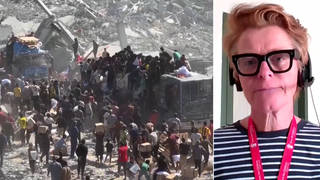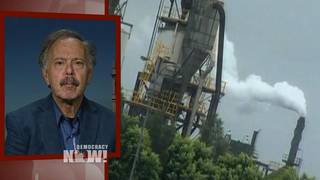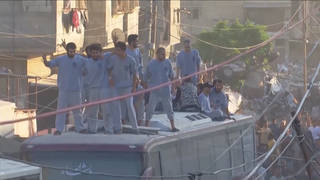
Guests
- Carl Safinaa MacArthur fellow, Pew fellow and Guggenheim fellow. He is founding president of Blue Ocean Institute and author of many books, including most recently A Sea in Flames: The Deepwater Horizon Oil Blowout.
Today marks the one-year anniversary of the worst maritime oil spill in U.S. history. Last year on April 20, the Deepwater Horizon rig, leased by oil giant BP, exploded in the Gulf of Mexico, killing 11 workers and releasing nearly 200 million gallons of oil, tens of millions of gallons of natural gas and 1.8 million gallons of other chemicals. A year later, how much has changed? “[Another spill] could happen again tomorrow. And if it did, the response would be as bad,” says Carl Safina, author of the new book, A Sea in Flames. Safina reviews BP, Halliburton and TransOcean’s role in the disaster and reflects on how little the government has done to prepare for another offshore drilling accident. [includes rush transcript]
Transcript
AMY GOODMAN: Today marks the one-year anniversary of the worst maritime oil spill in U.S. history. Last year on April 20th, the Deepwater Horizon rig leased by oil giant BP exploded in the Gulf of Mexico, killing 11 workers, releasing nearly 200 million gallons of oil, tens of millions of gallons of natural gas, 1.8 million gallons of chemicals.
Environmental groups and residents argue BP has yet to fulfill its financial and legal obligations. More than 500,000 Gulf residents have claimed compensation from a $20 billion fund set up by BP. But a large number of the claims have not yet been settled. Maritime life and communities in the area remain devastated.
JOHN HOCEVAR: Most of the oil is still there in the Gulf today. It’s in the water. It’s on the sediment. It’s on the seafloor. A lot of it’s washed up into the wetlands, and it’s still there. It’s still being eaten by marine life today.
AMY GOODMAN: Meanwhile, residents of affected coastal communities have reported various health problems. And the economy in the region has yet to recover, with fishermen and shrimpers reporting record losses in sales.
To discuss this, we’re joined by the world-renowned ecologist, Carl Safina. He is a MacArthur fellow, Pew fellow, Guggenheim fellow, founding president of Blue Ocean Institute, and the author of many books. His last is called A Sea in Flames: The Deepwater Horizon Oil Blowout.
Welcome to Democracy Now!, Carl.
CARL SAFINA: Thanks, Amy. Great to be back here.
AMY GOODMAN: It’s good to have you with us.
CARL SAFINA: Thank you.
AMY GOODMAN: Well, it was one year ago today. Describe exactly what happened.
CARL SAFINA: I think you could say four things caused the blowout. The first thing is that when they were going to leave the well — in other words, their job was to discover a large pool of oil; they discovered it; and then they were supposed to leave, seal the well, and have another rig at a later date come in and tap it for commercial purposes. They were going to seal the well with cement, not your typical hardware cement, but a very highly sophisticated formulation that can work at temperatures of hundreds of degrees and at the kinds of pressure that is thousands of feet below the sea surface. That cement, manufactured by Halliburton, failed several tests, but they used it anyway. That was the first thing.
Second problem, the rig owner, Transocean, had a large vat of a very sticky substance that they used to seal leaks in the well. This substance was left over. They needed to dispose of it. They’d have to take it ashore and dispose of it at hazardous waste, which would be very expensive, and instead they decided to put it down the well. The sticky stuff that they put down the well, which is very unusual to do, clogged up one of the pressure gauges. The pressure gauge would have shown that the cement was failing and that pressure was building as oil and gas was rushing into the well. But they got a reading of “no pressure” on that gauge. Another gauge was showing pressure building. They chose to ignore the gauge that was working properly and look at the one that it said, in the protocol, “Look at this gauge,” but they had clogged up that gauge by putting this stuff down the well so they wouldn’t have to pay to dispose of it onshore.
AMY GOODMAN: And who made that decision?
CARL SAFINA: The Transocean staff. BP went along with it.
The next thing that happened was that the BP people decided to continue to release the pressure on the well. They made the wrong judgment call about whether the pressure was or wasn’t building, looking at these two pressure gauges. And that was the blowout. Then, the blowout preventer, this stack of shears and valves on top of the wellhead, failed to trigger. It seems to have had a fundamental design flaw, in addition to what looks like some maintenance problems with it. The fundamental design flaw is that the force of the blowout shoved the pipe up and bent it slightly so it was just a couple of inches out of the spot where the shears would cut it. So the shears did not cut the pipe or seal the well.
At that point, the gas shot up the additional mile to the surface from the seafloor, and gas fumes were sucked into the generators. The generators started revving wildly. It was supposed to be air going in, but a flammable substance went in. A couple of sparks, it ignited all of that gas. And basically the rig turned into one giant Bunsen burner. And all of the controls to detach, to trigger the blowout preventer, all of that stuff failed. And in a series of explosions, the 11 people who were killed died in those initial explosions. The rig burned for two days and then sank.
AMY GOODMAN: The Coast Guard response?
CARL SAFINA: Well, there was no preparation for such an event, which there are several reasons for that, none of them good. And in one way, it’s very bizarre, when you think of it, that an oil industry, whose entire job is to make a hole in the seafloor and capture all the oil that comes out of that hole, had no way of dealing with oil coming out of a hole in the seafloor, because it was coming out of a broken pipe at that point. And they had no hardware to put on a leaking pipe at the seafloor.
The reason that the Coast Guard had no such thing, the reason that the oil companies had no such thing, is that in 30 years of extremely accelerated technological development for drilling in more sophisticated places, in deeper and deeper water, no energy and no money had been put into advancing the response technology. So, they could do things they could never do before, but they had no way of dealing with the likely eventuality that something would go wrong and that a pipe would be leaking. Why did that happen? Well, partly because the Oil Pollution Act of 1990 mandated that the government, in fact, develop response technologies, but it was constantly defunded in the budget. There was never any money allocated for trying to keep up with a response to the kind of sophisticated risks that were accelerating in drilling practices and drilling technology.
AMY GOODMAN: And do you feel like we have advanced at all in this year? Do you see this happening again?
CARL SAFINA: It could happen again tomorrow. And if it did, the response would be as bad. Two things, I would say, make it a little less likely. One is that I believe that the entire industry is quite chastened from the culture of it being more important to hurry up than to do things safely. So I would think that they are a little more careful. And the Obama administration broke up the Minerals Management Service into three agencies to avoid certain conflicts of interest that were inherent. In other words, prior to the blowout, the same agency that was there to encourage more drilling was also charged with the oversight of safety. And you can’t encourage them to hurry up and do a lot more at the same time where you’re suppose to be going slow and making sure things are safe. So, those agencies are separated now, and the oversight is a little bit better. But the hardware still isn’t there, and the economic incentives still are not really there to go slow, other than the fact that it was very costly for BP, and that should have chastened everybody. But if another blowout happened for the same reason or for another reason, because blowouts do happen, there’s no better hardware now, and there’s no better equipment now.
AMY GOODMAN: After the spill, I think most everyone remembers President Obama basically saying BP is in charge. Why didn’t the federal government federalize the situation, take control immediately? Do you think that would have been the answer? The answer he kept giving was, they’re the ones who know how to do this, though we had just watched them so miserably fail.
CARL SAFINA: I don’t think that was the real reason or a good reason, because in fact BP didn’t do anything. All they did was hire contractors to do stuff. The reason that BP was in charge is in the law. The law is based on the Exxon Valdez. It’s based on the idea that a tanker runs aground and spills its oil: well, if you screw up, you should pick it up. And that’s what the law says. The law never anticipated a month-long blowout. It should have, because there was one 30 years ago in the Gulf on the Mexican side that lasted for nine months in much shallower water. But the law was based on a template of a tanker ruptures, and the company must clean it up.
But here, the situation got really out of hand. Oil was gushing for months. It was all over our property. It was no longer a matter of one contained thing. It wasn’t just what was in the tanker is the sum of it. There was an almost unlimited amount. It could have gushed for many more months. And the law was just not equipped to deal with that kind of a situation. Now, I think that because people were already saying that this could be Obama’s Katrina and trying to shift blame, I imagine and I believe that the administration was simply terrified that all of the inadequate response and all of the subsequent screwups would be blamed on them, and I think they wanted to try to keep the focus on BP, so they left the situation as the law prescribes rather than coming in and trying to federalize it. Federalizing it would have meant an agency like FEMA, the federal emergency agency, which had so badly handled Katrina, would take over and hire and deploy those same contractors. I don’t think the result would have been any better, except that the incredible nonsense of BP and all these private guards throughout the Gulf trying to prevent people from understanding what was going on, trying to turn camera crews away, succeeding in many cases, would not have been allowed to go on.
AMY GOODMAN: I want to end with what you wrote in your piece, “One Year Later: Assessing the Lasting Impact of the Gulf Spill.” “The worst environmental disaster in history isn’t the oil that gets away. It’s the oil we burn, the coal we burn, the gas we burn. The real catastrophic spill is the carbon dioxide billowing from our tailpipes and smokestacks every second, year upon decade. That spill is destabilizing the planet’s life-supporting systems, killing polar wildlife, shrinking tropical reefs, dissolving shellfish, raising the sea level along densely populated coasts, jeopardizing agriculture, and threatening food security for hundreds of millions of people.” The alternative, in the biggest sense, Carl Safina?
CARL SAFINA: The alternative is that eternal energy powers the whole planet: the energy of the sun, the strength of the wind, the power of the tides, the heat of the earth, all the algae that powers all of the life in the ocean. Petroleum, after all, is algae that’s been cooking at the bottom of the sea for millions of years. You can make jet fuel with genetically engineered algae. It’s been done. Jets have been flown on it. We have the ability to harness all of the eternal sources of energy that really power the planet. And instead, in this country, we’re stuck doing what we’ve done ever since we lived in caves: whenever we want some energy, we light fire to something. The United States is stuck in a debate that says that harnessing the eternal sources of energy that run the planet are too expensive and too impractical, but China is not under that delusion, neither is Germany or Denmark or Spain or Canada. All these countries are ahead of us in developing clean technologies, diversified energy sources, creating the jobs that go with it, and building the infrastructure that goes with it, as we pretend that it’s impractical, while our factories rust and we complain about high unemployment.
AMY GOODMAN: On that note, I want to thank you very much, Carl Safina, for kicking off our show on this first anniversary of the Gulf oil spill. His book is A Sea in Flames: The Deepwater Horizon Oil Blowout. This is Democracy Now!, democracynow.org, The War and Peace Report. When we come back, we go to New Orleans, we go to Baton Rouge, we go to Alabama, we go to Texas. Stay with us.












Media Options